Best Practices in Health Care for Intellectual Disability Patients
VerifiedAdded on 2022/08/10
|9
|2063
|23
Report
AI Summary
This report provides a comprehensive overview of health care considerations for individuals with intellectual disabilities, focusing on assessment, management of dysphagia, and practical applications. The report begins by outlining crucial factors to consider during health assessments, including comorbidities, behavioral observations, and the importance of patient-centered care. It then delves into dysphagia, a common swallowing difficulty, detailing the different types, assessment methods (such as the DDS and various tests), and management strategies. The report concludes with a reflection on a student's clinical placement experience, highlighting best practices in medication administration, postural techniques to aid swallowing, and the use of alternative feeding methods like PEG, along with ethical and legal considerations. The report emphasizes the importance of collaboration, informed consent, and adherence to infection control protocols in providing high-quality care.
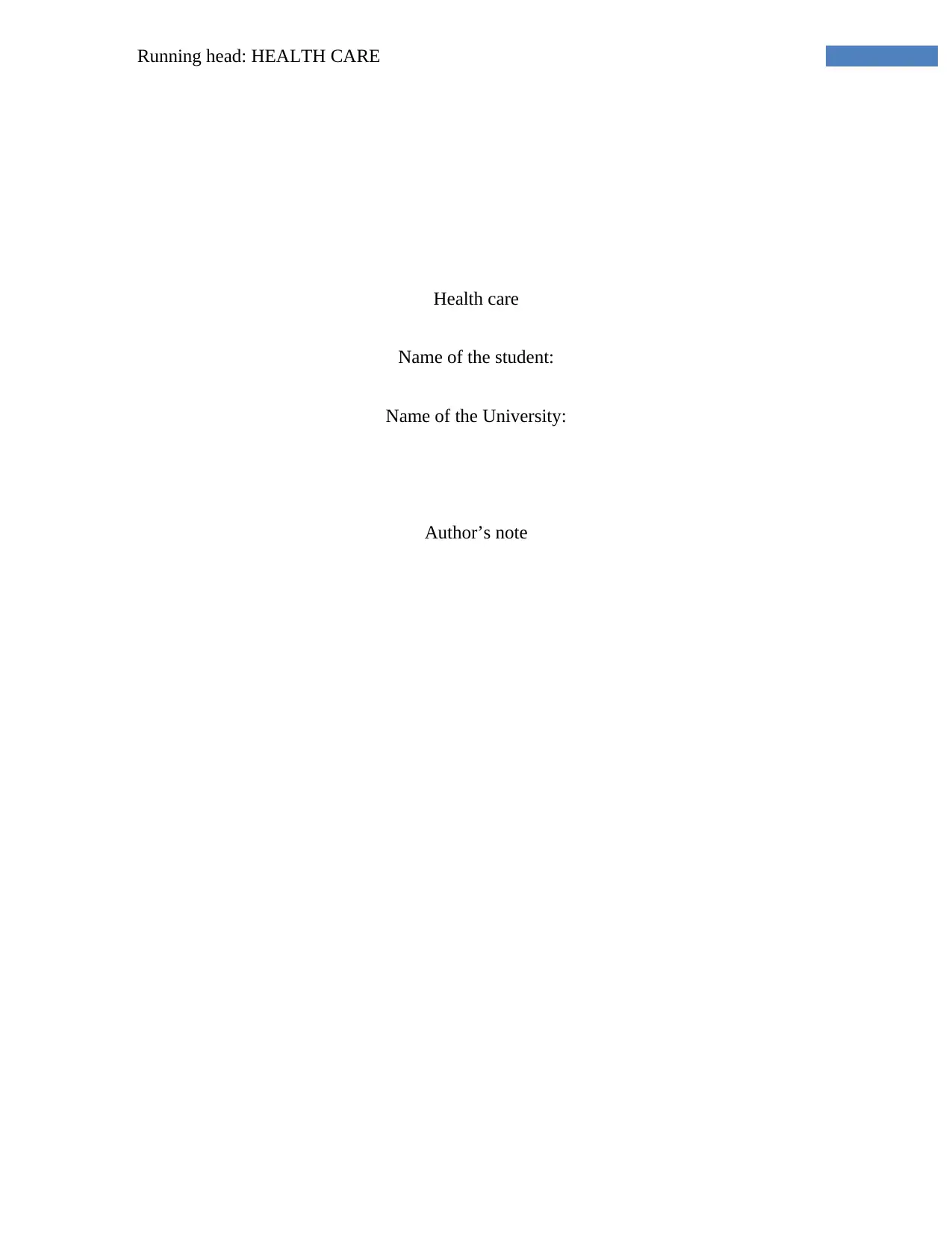
Running head: HEALTH CARE
Health care
Name of the student:
Name of the University:
Author’s note
Health care
Name of the student:
Name of the University:
Author’s note
Paraphrase This Document
Need a fresh take? Get an instant paraphrase of this document with our AI Paraphraser
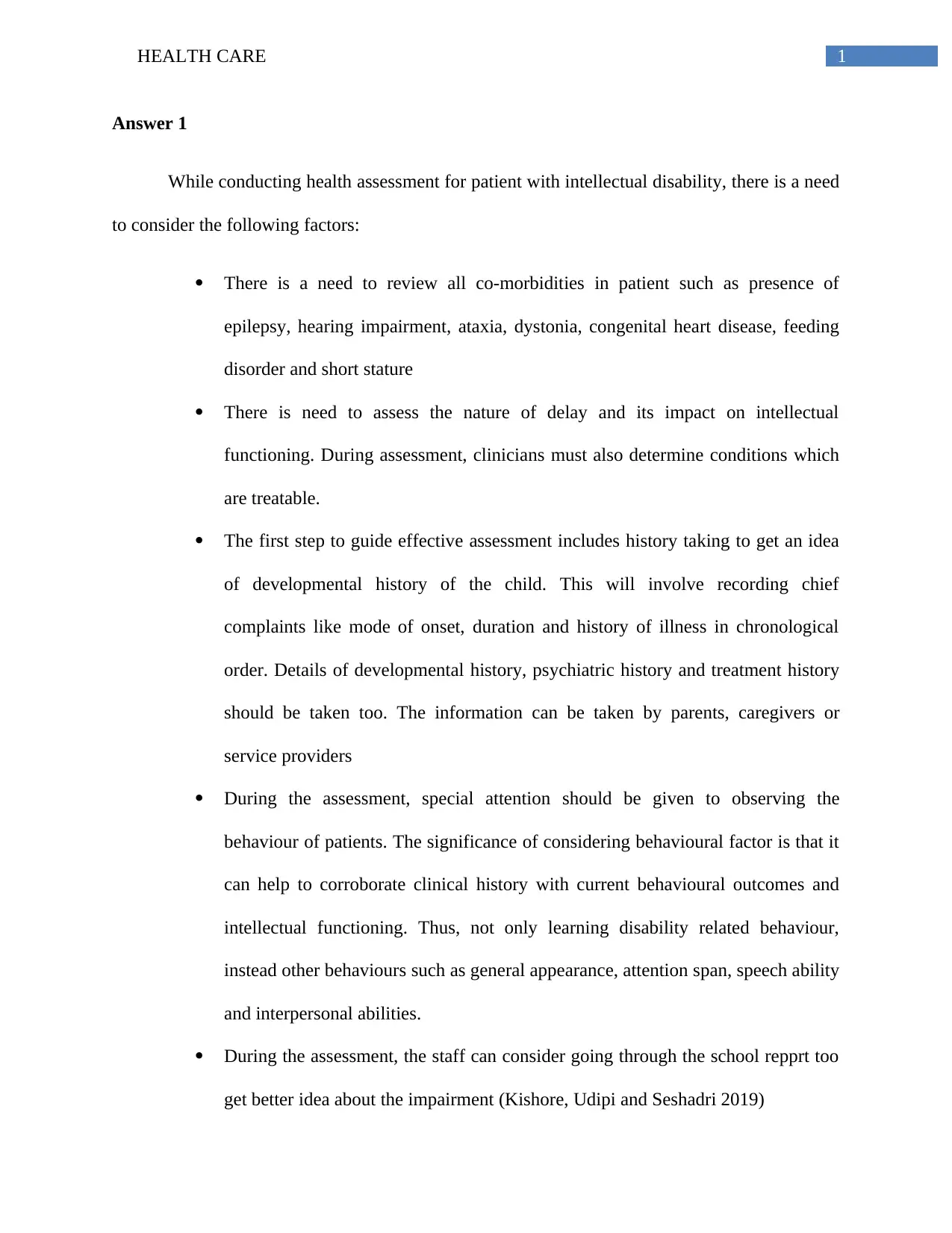
1HEALTH CARE
Answer 1
While conducting health assessment for patient with intellectual disability, there is a need
to consider the following factors:
There is a need to review all co-morbidities in patient such as presence of
epilepsy, hearing impairment, ataxia, dystonia, congenital heart disease, feeding
disorder and short stature
There is need to assess the nature of delay and its impact on intellectual
functioning. During assessment, clinicians must also determine conditions which
are treatable.
The first step to guide effective assessment includes history taking to get an idea
of developmental history of the child. This will involve recording chief
complaints like mode of onset, duration and history of illness in chronological
order. Details of developmental history, psychiatric history and treatment history
should be taken too. The information can be taken by parents, caregivers or
service providers
During the assessment, special attention should be given to observing the
behaviour of patients. The significance of considering behavioural factor is that it
can help to corroborate clinical history with current behavioural outcomes and
intellectual functioning. Thus, not only learning disability related behaviour,
instead other behaviours such as general appearance, attention span, speech ability
and interpersonal abilities.
During the assessment, the staff can consider going through the school repprt too
get better idea about the impairment (Kishore, Udipi and Seshadri 2019)
Answer 1
While conducting health assessment for patient with intellectual disability, there is a need
to consider the following factors:
There is a need to review all co-morbidities in patient such as presence of
epilepsy, hearing impairment, ataxia, dystonia, congenital heart disease, feeding
disorder and short stature
There is need to assess the nature of delay and its impact on intellectual
functioning. During assessment, clinicians must also determine conditions which
are treatable.
The first step to guide effective assessment includes history taking to get an idea
of developmental history of the child. This will involve recording chief
complaints like mode of onset, duration and history of illness in chronological
order. Details of developmental history, psychiatric history and treatment history
should be taken too. The information can be taken by parents, caregivers or
service providers
During the assessment, special attention should be given to observing the
behaviour of patients. The significance of considering behavioural factor is that it
can help to corroborate clinical history with current behavioural outcomes and
intellectual functioning. Thus, not only learning disability related behaviour,
instead other behaviours such as general appearance, attention span, speech ability
and interpersonal abilities.
During the assessment, the staff can consider going through the school repprt too
get better idea about the impairment (Kishore, Udipi and Seshadri 2019)
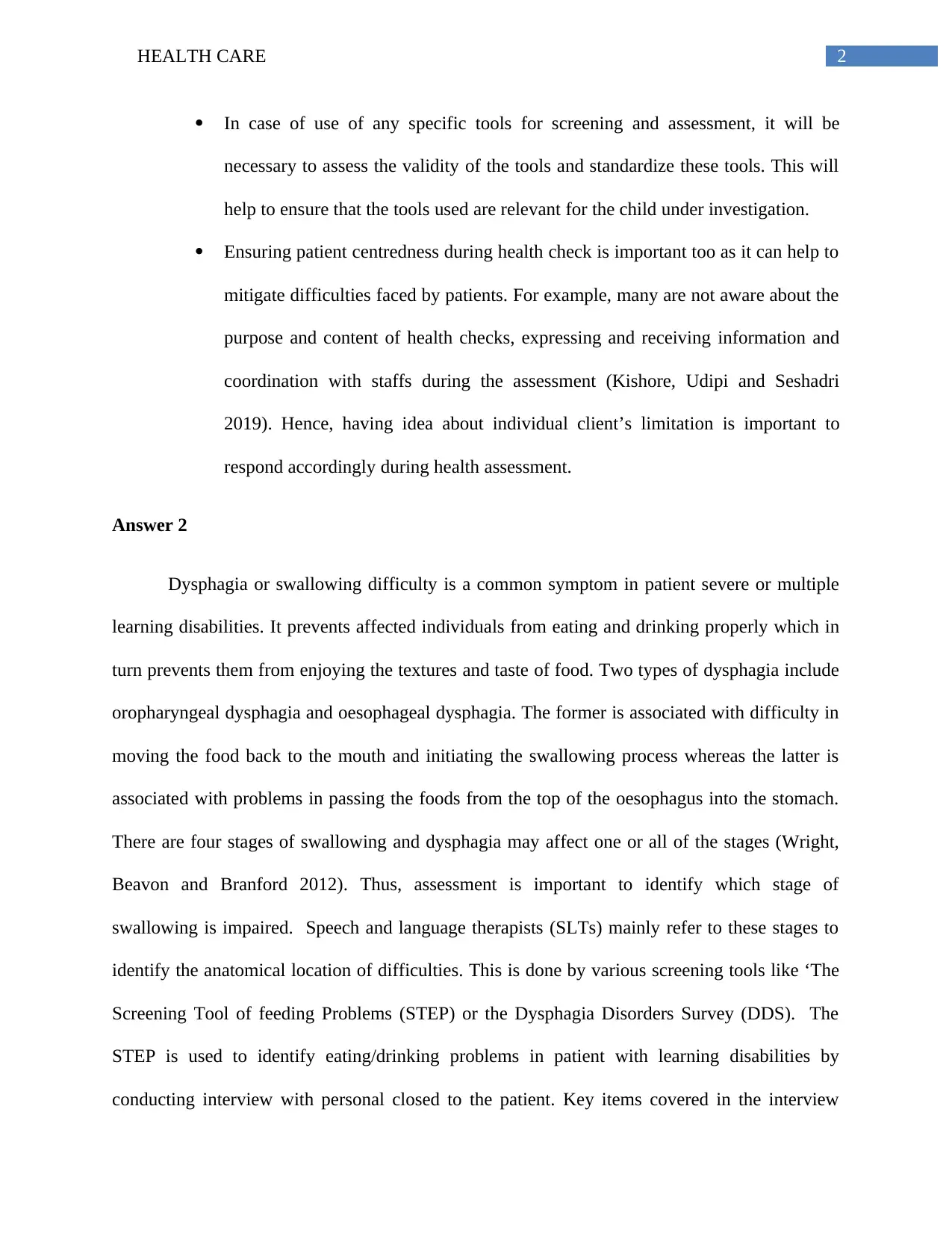
2HEALTH CARE
In case of use of any specific tools for screening and assessment, it will be
necessary to assess the validity of the tools and standardize these tools. This will
help to ensure that the tools used are relevant for the child under investigation.
Ensuring patient centredness during health check is important too as it can help to
mitigate difficulties faced by patients. For example, many are not aware about the
purpose and content of health checks, expressing and receiving information and
coordination with staffs during the assessment (Kishore, Udipi and Seshadri
2019). Hence, having idea about individual client’s limitation is important to
respond accordingly during health assessment.
Answer 2
Dysphagia or swallowing difficulty is a common symptom in patient severe or multiple
learning disabilities. It prevents affected individuals from eating and drinking properly which in
turn prevents them from enjoying the textures and taste of food. Two types of dysphagia include
oropharyngeal dysphagia and oesophageal dysphagia. The former is associated with difficulty in
moving the food back to the mouth and initiating the swallowing process whereas the latter is
associated with problems in passing the foods from the top of the oesophagus into the stomach.
There are four stages of swallowing and dysphagia may affect one or all of the stages (Wright,
Beavon and Branford 2012). Thus, assessment is important to identify which stage of
swallowing is impaired. Speech and language therapists (SLTs) mainly refer to these stages to
identify the anatomical location of difficulties. This is done by various screening tools like ‘The
Screening Tool of feeding Problems (STEP) or the Dysphagia Disorders Survey (DDS). The
STEP is used to identify eating/drinking problems in patient with learning disabilities by
conducting interview with personal closed to the patient. Key items covered in the interview
In case of use of any specific tools for screening and assessment, it will be
necessary to assess the validity of the tools and standardize these tools. This will
help to ensure that the tools used are relevant for the child under investigation.
Ensuring patient centredness during health check is important too as it can help to
mitigate difficulties faced by patients. For example, many are not aware about the
purpose and content of health checks, expressing and receiving information and
coordination with staffs during the assessment (Kishore, Udipi and Seshadri
2019). Hence, having idea about individual client’s limitation is important to
respond accordingly during health assessment.
Answer 2
Dysphagia or swallowing difficulty is a common symptom in patient severe or multiple
learning disabilities. It prevents affected individuals from eating and drinking properly which in
turn prevents them from enjoying the textures and taste of food. Two types of dysphagia include
oropharyngeal dysphagia and oesophageal dysphagia. The former is associated with difficulty in
moving the food back to the mouth and initiating the swallowing process whereas the latter is
associated with problems in passing the foods from the top of the oesophagus into the stomach.
There are four stages of swallowing and dysphagia may affect one or all of the stages (Wright,
Beavon and Branford 2012). Thus, assessment is important to identify which stage of
swallowing is impaired. Speech and language therapists (SLTs) mainly refer to these stages to
identify the anatomical location of difficulties. This is done by various screening tools like ‘The
Screening Tool of feeding Problems (STEP) or the Dysphagia Disorders Survey (DDS). The
STEP is used to identify eating/drinking problems in patient with learning disabilities by
conducting interview with personal closed to the patient. Key items covered in the interview
⊘ This is a preview!⊘
Do you want full access?
Subscribe today to unlock all pages.

Trusted by 1+ million students worldwide
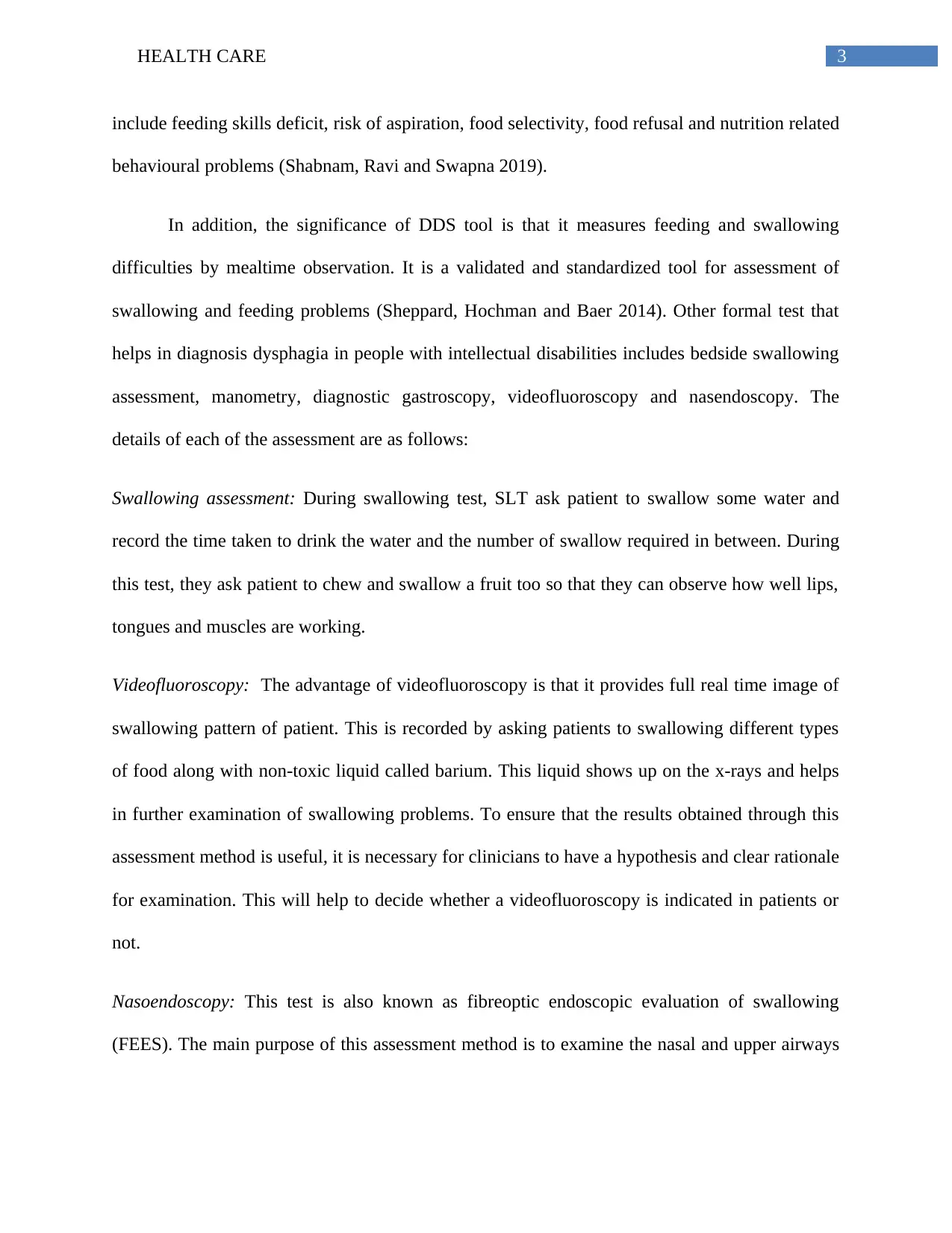
3HEALTH CARE
include feeding skills deficit, risk of aspiration, food selectivity, food refusal and nutrition related
behavioural problems (Shabnam, Ravi and Swapna 2019).
In addition, the significance of DDS tool is that it measures feeding and swallowing
difficulties by mealtime observation. It is a validated and standardized tool for assessment of
swallowing and feeding problems (Sheppard, Hochman and Baer 2014). Other formal test that
helps in diagnosis dysphagia in people with intellectual disabilities includes bedside swallowing
assessment, manometry, diagnostic gastroscopy, videofluoroscopy and nasendoscopy. The
details of each of the assessment are as follows:
Swallowing assessment: During swallowing test, SLT ask patient to swallow some water and
record the time taken to drink the water and the number of swallow required in between. During
this test, they ask patient to chew and swallow a fruit too so that they can observe how well lips,
tongues and muscles are working.
Videofluoroscopy: The advantage of videofluoroscopy is that it provides full real time image of
swallowing pattern of patient. This is recorded by asking patients to swallowing different types
of food along with non-toxic liquid called barium. This liquid shows up on the x-rays and helps
in further examination of swallowing problems. To ensure that the results obtained through this
assessment method is useful, it is necessary for clinicians to have a hypothesis and clear rationale
for examination. This will help to decide whether a videofluoroscopy is indicated in patients or
not.
Nasoendoscopy: This test is also known as fibreoptic endoscopic evaluation of swallowing
(FEES). The main purpose of this assessment method is to examine the nasal and upper airways
include feeding skills deficit, risk of aspiration, food selectivity, food refusal and nutrition related
behavioural problems (Shabnam, Ravi and Swapna 2019).
In addition, the significance of DDS tool is that it measures feeding and swallowing
difficulties by mealtime observation. It is a validated and standardized tool for assessment of
swallowing and feeding problems (Sheppard, Hochman and Baer 2014). Other formal test that
helps in diagnosis dysphagia in people with intellectual disabilities includes bedside swallowing
assessment, manometry, diagnostic gastroscopy, videofluoroscopy and nasendoscopy. The
details of each of the assessment are as follows:
Swallowing assessment: During swallowing test, SLT ask patient to swallow some water and
record the time taken to drink the water and the number of swallow required in between. During
this test, they ask patient to chew and swallow a fruit too so that they can observe how well lips,
tongues and muscles are working.
Videofluoroscopy: The advantage of videofluoroscopy is that it provides full real time image of
swallowing pattern of patient. This is recorded by asking patients to swallowing different types
of food along with non-toxic liquid called barium. This liquid shows up on the x-rays and helps
in further examination of swallowing problems. To ensure that the results obtained through this
assessment method is useful, it is necessary for clinicians to have a hypothesis and clear rationale
for examination. This will help to decide whether a videofluoroscopy is indicated in patients or
not.
Nasoendoscopy: This test is also known as fibreoptic endoscopic evaluation of swallowing
(FEES). The main purpose of this assessment method is to examine the nasal and upper airways
Paraphrase This Document
Need a fresh take? Get an instant paraphrase of this document with our AI Paraphraser
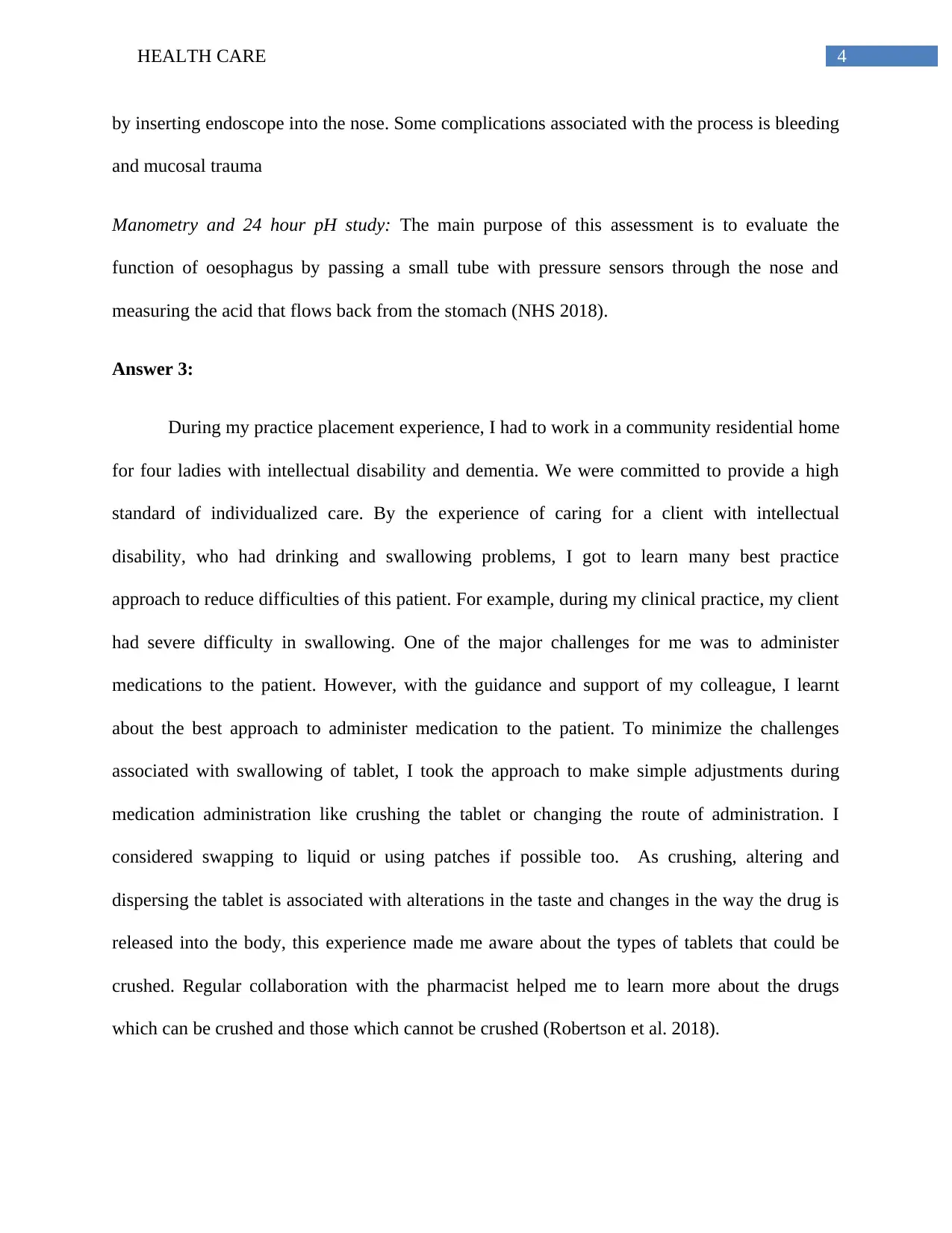
4HEALTH CARE
by inserting endoscope into the nose. Some complications associated with the process is bleeding
and mucosal trauma
Manometry and 24 hour pH study: The main purpose of this assessment is to evaluate the
function of oesophagus by passing a small tube with pressure sensors through the nose and
measuring the acid that flows back from the stomach (NHS 2018).
Answer 3:
During my practice placement experience, I had to work in a community residential home
for four ladies with intellectual disability and dementia. We were committed to provide a high
standard of individualized care. By the experience of caring for a client with intellectual
disability, who had drinking and swallowing problems, I got to learn many best practice
approach to reduce difficulties of this patient. For example, during my clinical practice, my client
had severe difficulty in swallowing. One of the major challenges for me was to administer
medications to the patient. However, with the guidance and support of my colleague, I learnt
about the best approach to administer medication to the patient. To minimize the challenges
associated with swallowing of tablet, I took the approach to make simple adjustments during
medication administration like crushing the tablet or changing the route of administration. I
considered swapping to liquid or using patches if possible too. As crushing, altering and
dispersing the tablet is associated with alterations in the taste and changes in the way the drug is
released into the body, this experience made me aware about the types of tablets that could be
crushed. Regular collaboration with the pharmacist helped me to learn more about the drugs
which can be crushed and those which cannot be crushed (Robertson et al. 2018).
by inserting endoscope into the nose. Some complications associated with the process is bleeding
and mucosal trauma
Manometry and 24 hour pH study: The main purpose of this assessment is to evaluate the
function of oesophagus by passing a small tube with pressure sensors through the nose and
measuring the acid that flows back from the stomach (NHS 2018).
Answer 3:
During my practice placement experience, I had to work in a community residential home
for four ladies with intellectual disability and dementia. We were committed to provide a high
standard of individualized care. By the experience of caring for a client with intellectual
disability, who had drinking and swallowing problems, I got to learn many best practice
approach to reduce difficulties of this patient. For example, during my clinical practice, my client
had severe difficulty in swallowing. One of the major challenges for me was to administer
medications to the patient. However, with the guidance and support of my colleague, I learnt
about the best approach to administer medication to the patient. To minimize the challenges
associated with swallowing of tablet, I took the approach to make simple adjustments during
medication administration like crushing the tablet or changing the route of administration. I
considered swapping to liquid or using patches if possible too. As crushing, altering and
dispersing the tablet is associated with alterations in the taste and changes in the way the drug is
released into the body, this experience made me aware about the types of tablets that could be
crushed. Regular collaboration with the pharmacist helped me to learn more about the drugs
which can be crushed and those which cannot be crushed (Robertson et al. 2018).
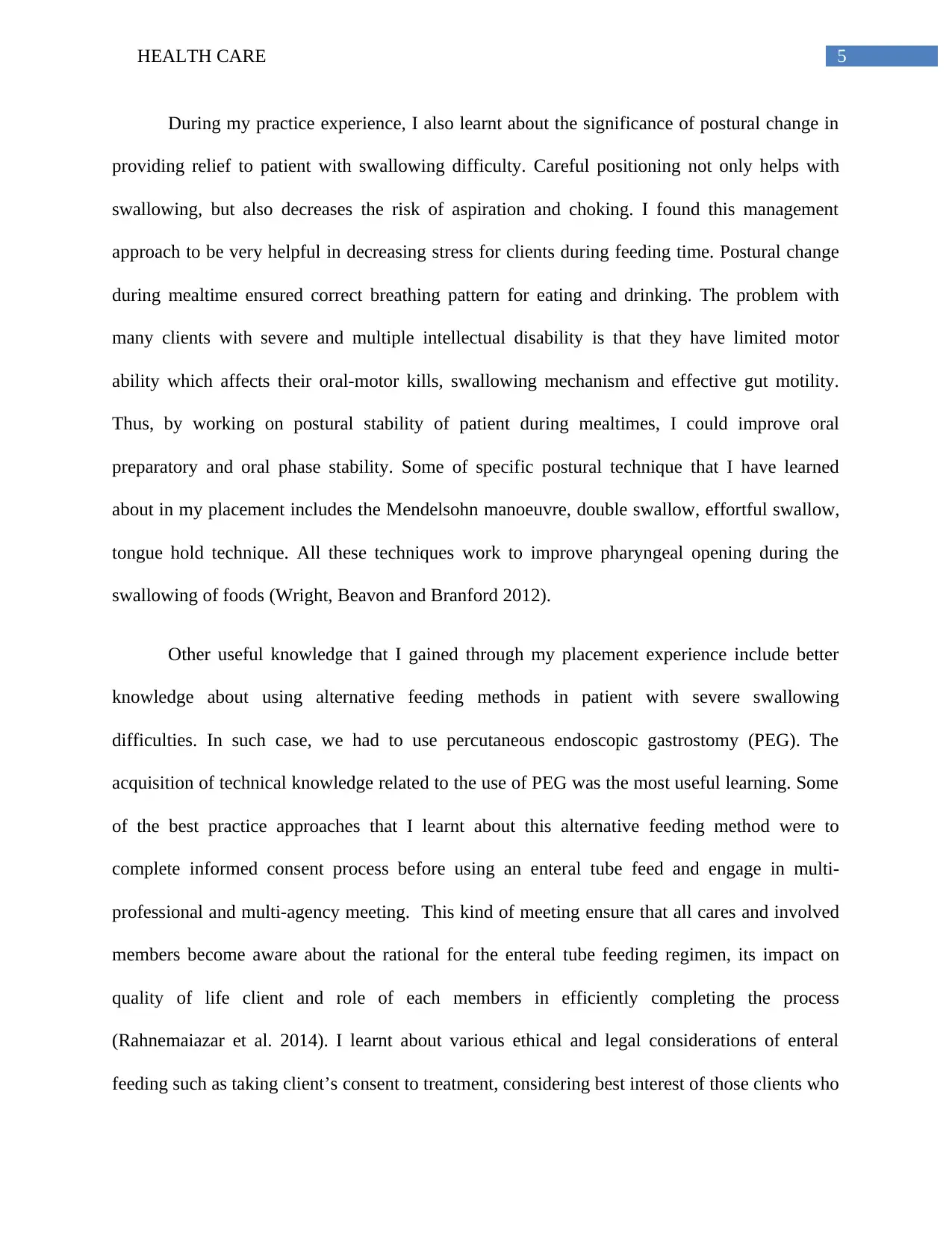
5HEALTH CARE
During my practice experience, I also learnt about the significance of postural change in
providing relief to patient with swallowing difficulty. Careful positioning not only helps with
swallowing, but also decreases the risk of aspiration and choking. I found this management
approach to be very helpful in decreasing stress for clients during feeding time. Postural change
during mealtime ensured correct breathing pattern for eating and drinking. The problem with
many clients with severe and multiple intellectual disability is that they have limited motor
ability which affects their oral-motor kills, swallowing mechanism and effective gut motility.
Thus, by working on postural stability of patient during mealtimes, I could improve oral
preparatory and oral phase stability. Some of specific postural technique that I have learned
about in my placement includes the Mendelsohn manoeuvre, double swallow, effortful swallow,
tongue hold technique. All these techniques work to improve pharyngeal opening during the
swallowing of foods (Wright, Beavon and Branford 2012).
Other useful knowledge that I gained through my placement experience include better
knowledge about using alternative feeding methods in patient with severe swallowing
difficulties. In such case, we had to use percutaneous endoscopic gastrostomy (PEG). The
acquisition of technical knowledge related to the use of PEG was the most useful learning. Some
of the best practice approaches that I learnt about this alternative feeding method were to
complete informed consent process before using an enteral tube feed and engage in multi-
professional and multi-agency meeting. This kind of meeting ensure that all cares and involved
members become aware about the rational for the enteral tube feeding regimen, its impact on
quality of life client and role of each members in efficiently completing the process
(Rahnemaiazar et al. 2014). I learnt about various ethical and legal considerations of enteral
feeding such as taking client’s consent to treatment, considering best interest of those clients who
During my practice experience, I also learnt about the significance of postural change in
providing relief to patient with swallowing difficulty. Careful positioning not only helps with
swallowing, but also decreases the risk of aspiration and choking. I found this management
approach to be very helpful in decreasing stress for clients during feeding time. Postural change
during mealtime ensured correct breathing pattern for eating and drinking. The problem with
many clients with severe and multiple intellectual disability is that they have limited motor
ability which affects their oral-motor kills, swallowing mechanism and effective gut motility.
Thus, by working on postural stability of patient during mealtimes, I could improve oral
preparatory and oral phase stability. Some of specific postural technique that I have learned
about in my placement includes the Mendelsohn manoeuvre, double swallow, effortful swallow,
tongue hold technique. All these techniques work to improve pharyngeal opening during the
swallowing of foods (Wright, Beavon and Branford 2012).
Other useful knowledge that I gained through my placement experience include better
knowledge about using alternative feeding methods in patient with severe swallowing
difficulties. In such case, we had to use percutaneous endoscopic gastrostomy (PEG). The
acquisition of technical knowledge related to the use of PEG was the most useful learning. Some
of the best practice approaches that I learnt about this alternative feeding method were to
complete informed consent process before using an enteral tube feed and engage in multi-
professional and multi-agency meeting. This kind of meeting ensure that all cares and involved
members become aware about the rational for the enteral tube feeding regimen, its impact on
quality of life client and role of each members in efficiently completing the process
(Rahnemaiazar et al. 2014). I learnt about various ethical and legal considerations of enteral
feeding such as taking client’s consent to treatment, considering best interest of those clients who
⊘ This is a preview!⊘
Do you want full access?
Subscribe today to unlock all pages.

Trusted by 1+ million students worldwide
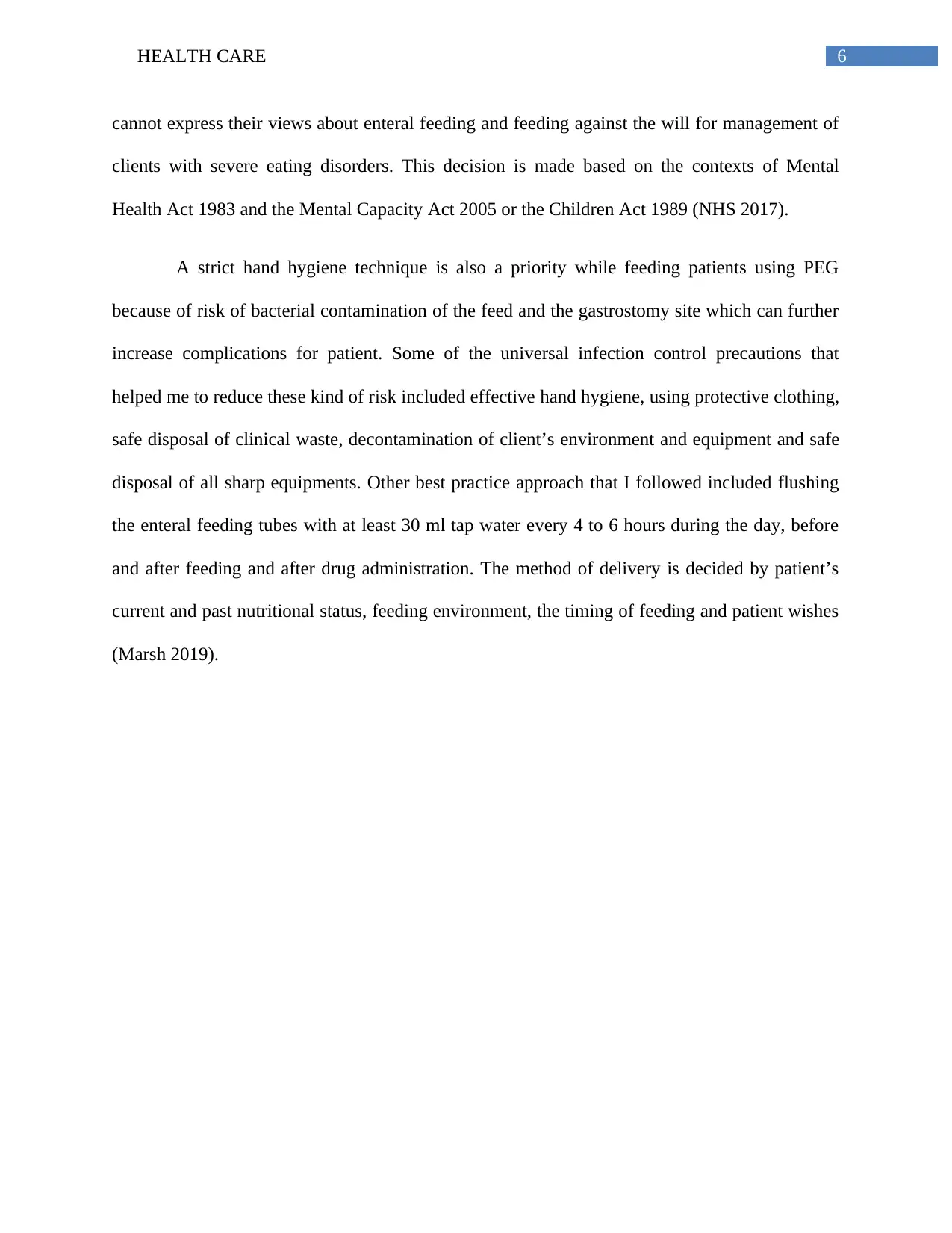
6HEALTH CARE
cannot express their views about enteral feeding and feeding against the will for management of
clients with severe eating disorders. This decision is made based on the contexts of Mental
Health Act 1983 and the Mental Capacity Act 2005 or the Children Act 1989 (NHS 2017).
A strict hand hygiene technique is also a priority while feeding patients using PEG
because of risk of bacterial contamination of the feed and the gastrostomy site which can further
increase complications for patient. Some of the universal infection control precautions that
helped me to reduce these kind of risk included effective hand hygiene, using protective clothing,
safe disposal of clinical waste, decontamination of client’s environment and equipment and safe
disposal of all sharp equipments. Other best practice approach that I followed included flushing
the enteral feeding tubes with at least 30 ml tap water every 4 to 6 hours during the day, before
and after feeding and after drug administration. The method of delivery is decided by patient’s
current and past nutritional status, feeding environment, the timing of feeding and patient wishes
(Marsh 2019).
cannot express their views about enteral feeding and feeding against the will for management of
clients with severe eating disorders. This decision is made based on the contexts of Mental
Health Act 1983 and the Mental Capacity Act 2005 or the Children Act 1989 (NHS 2017).
A strict hand hygiene technique is also a priority while feeding patients using PEG
because of risk of bacterial contamination of the feed and the gastrostomy site which can further
increase complications for patient. Some of the universal infection control precautions that
helped me to reduce these kind of risk included effective hand hygiene, using protective clothing,
safe disposal of clinical waste, decontamination of client’s environment and equipment and safe
disposal of all sharp equipments. Other best practice approach that I followed included flushing
the enteral feeding tubes with at least 30 ml tap water every 4 to 6 hours during the day, before
and after feeding and after drug administration. The method of delivery is decided by patient’s
current and past nutritional status, feeding environment, the timing of feeding and patient wishes
(Marsh 2019).
Paraphrase This Document
Need a fresh take? Get an instant paraphrase of this document with our AI Paraphraser
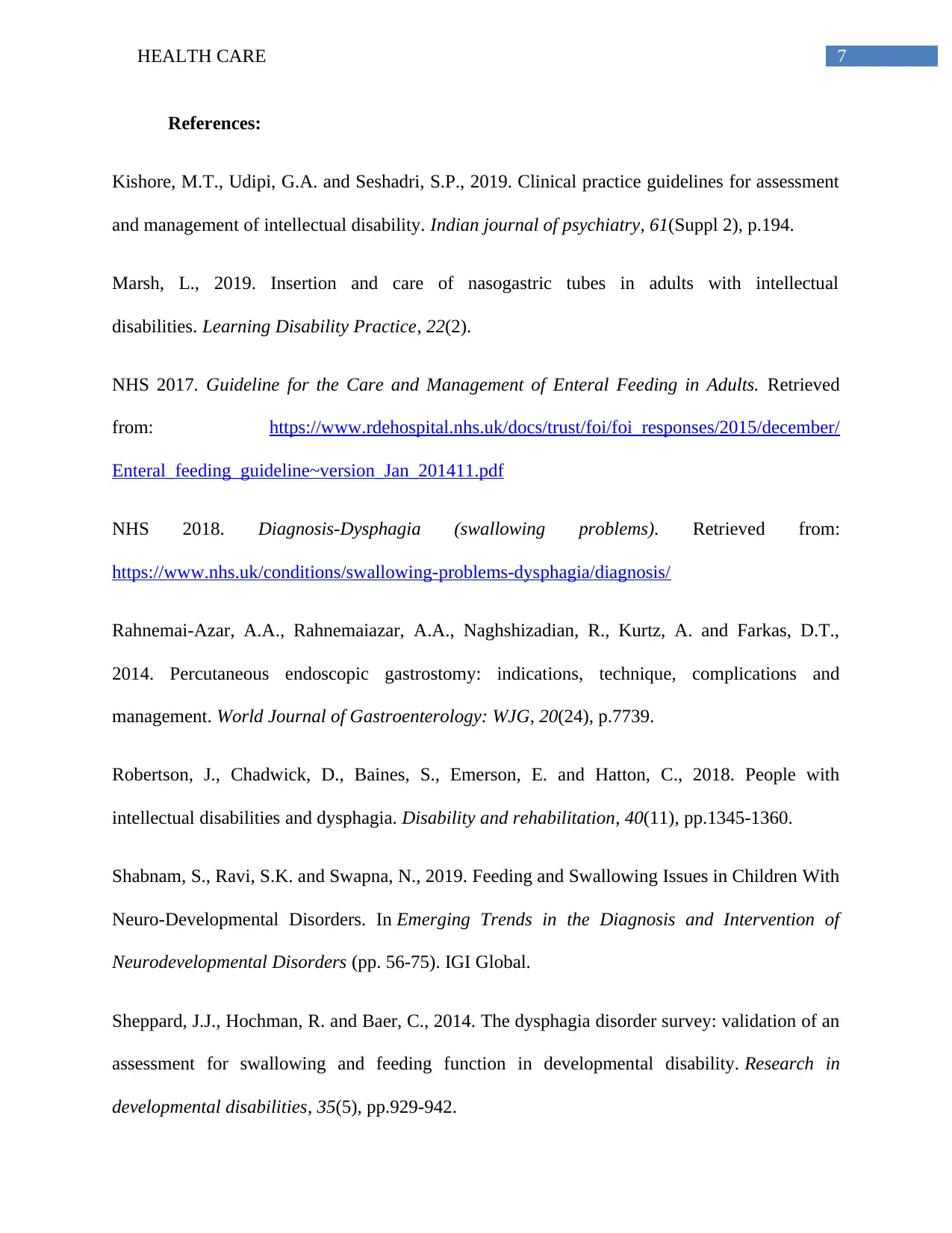
7HEALTH CARE
References:
Kishore, M.T., Udipi, G.A. and Seshadri, S.P., 2019. Clinical practice guidelines for assessment
and management of intellectual disability. Indian journal of psychiatry, 61(Suppl 2), p.194.
Marsh, L., 2019. Insertion and care of nasogastric tubes in adults with intellectual
disabilities. Learning Disability Practice, 22(2).
NHS 2017. Guideline for the Care and Management of Enteral Feeding in Adults. Retrieved
from: https://www.rdehospital.nhs.uk/docs/trust/foi/foi_responses/2015/december/
Enteral_feeding_guideline~version_Jan_201411.pdf
NHS 2018. Diagnosis-Dysphagia (swallowing problems). Retrieved from:
https://www.nhs.uk/conditions/swallowing-problems-dysphagia/diagnosis/
Rahnemai-Azar, A.A., Rahnemaiazar, A.A., Naghshizadian, R., Kurtz, A. and Farkas, D.T.,
2014. Percutaneous endoscopic gastrostomy: indications, technique, complications and
management. World Journal of Gastroenterology: WJG, 20(24), p.7739.
Robertson, J., Chadwick, D., Baines, S., Emerson, E. and Hatton, C., 2018. People with
intellectual disabilities and dysphagia. Disability and rehabilitation, 40(11), pp.1345-1360.
Shabnam, S., Ravi, S.K. and Swapna, N., 2019. Feeding and Swallowing Issues in Children With
Neuro-Developmental Disorders. In Emerging Trends in the Diagnosis and Intervention of
Neurodevelopmental Disorders (pp. 56-75). IGI Global.
Sheppard, J.J., Hochman, R. and Baer, C., 2014. The dysphagia disorder survey: validation of an
assessment for swallowing and feeding function in developmental disability. Research in
developmental disabilities, 35(5), pp.929-942.
References:
Kishore, M.T., Udipi, G.A. and Seshadri, S.P., 2019. Clinical practice guidelines for assessment
and management of intellectual disability. Indian journal of psychiatry, 61(Suppl 2), p.194.
Marsh, L., 2019. Insertion and care of nasogastric tubes in adults with intellectual
disabilities. Learning Disability Practice, 22(2).
NHS 2017. Guideline for the Care and Management of Enteral Feeding in Adults. Retrieved
from: https://www.rdehospital.nhs.uk/docs/trust/foi/foi_responses/2015/december/
Enteral_feeding_guideline~version_Jan_201411.pdf
NHS 2018. Diagnosis-Dysphagia (swallowing problems). Retrieved from:
https://www.nhs.uk/conditions/swallowing-problems-dysphagia/diagnosis/
Rahnemai-Azar, A.A., Rahnemaiazar, A.A., Naghshizadian, R., Kurtz, A. and Farkas, D.T.,
2014. Percutaneous endoscopic gastrostomy: indications, technique, complications and
management. World Journal of Gastroenterology: WJG, 20(24), p.7739.
Robertson, J., Chadwick, D., Baines, S., Emerson, E. and Hatton, C., 2018. People with
intellectual disabilities and dysphagia. Disability and rehabilitation, 40(11), pp.1345-1360.
Shabnam, S., Ravi, S.K. and Swapna, N., 2019. Feeding and Swallowing Issues in Children With
Neuro-Developmental Disorders. In Emerging Trends in the Diagnosis and Intervention of
Neurodevelopmental Disorders (pp. 56-75). IGI Global.
Sheppard, J.J., Hochman, R. and Baer, C., 2014. The dysphagia disorder survey: validation of an
assessment for swallowing and feeding function in developmental disability. Research in
developmental disabilities, 35(5), pp.929-942.
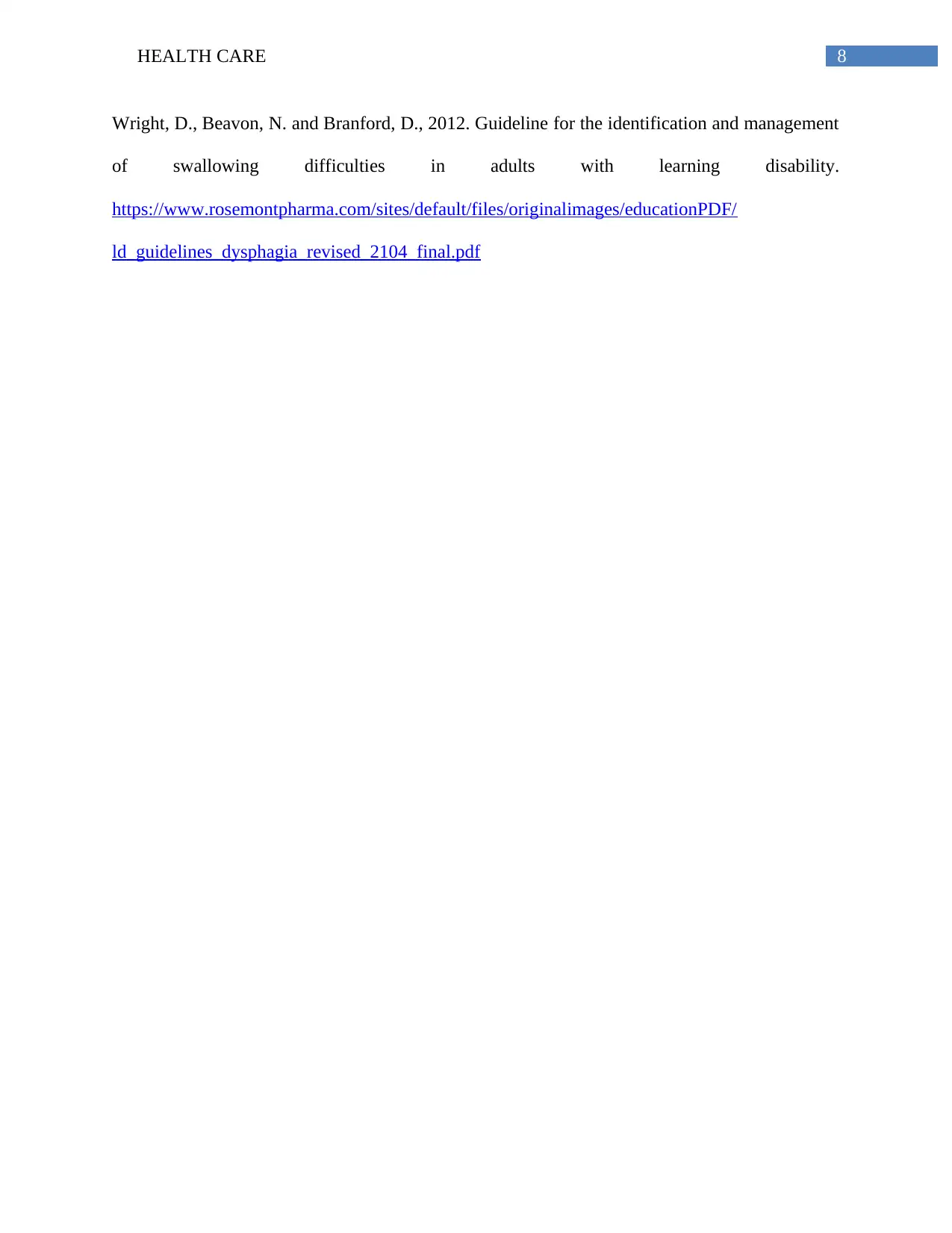
8HEALTH CARE
Wright, D., Beavon, N. and Branford, D., 2012. Guideline for the identification and management
of swallowing difficulties in adults with learning disability.
https://www.rosemontpharma.com/sites/default/files/originalimages/educationPDF/
ld_guidelines_dysphagia_revised_2104_final.pdf
Wright, D., Beavon, N. and Branford, D., 2012. Guideline for the identification and management
of swallowing difficulties in adults with learning disability.
https://www.rosemontpharma.com/sites/default/files/originalimages/educationPDF/
ld_guidelines_dysphagia_revised_2104_final.pdf
⊘ This is a preview!⊘
Do you want full access?
Subscribe today to unlock all pages.

Trusted by 1+ million students worldwide
1 out of 9
Related Documents
Your All-in-One AI-Powered Toolkit for Academic Success.
+13062052269
info@desklib.com
Available 24*7 on WhatsApp / Email
![[object Object]](/_next/static/media/star-bottom.7253800d.svg)
Unlock your academic potential
Copyright © 2020–2025 A2Z Services. All Rights Reserved. Developed and managed by ZUCOL.





